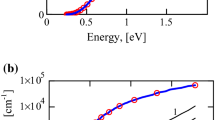Abstract
With the assumption of the Franz-Keldysh effect as the origination mechanism of the interband electromodulation E 0 component, a generalized multilayer model of this effect was proposed. This model includes such physical parameters as the strength of the surface electric field and its decay profile in the space charge region, energy broadening, and partial modulation of the surface electric field. It was shown that the three regions can be defined in the simulated spectra, namely, the low-energy region, the region of main peak, and the high-energy region of the Franz-Keldysh oscillations. The effect of the model parameters on the line shape in these regions was studied. The ranges of the actual parameters were determined from the quantitative analysis of the experimental photoreflectance spectra of GaAs and InP substrates (n=1015 cm−3–1018 cm−3).
Similar content being viewed by others
References
M. Cardona, Modulation Spectroscopy (Academic, New York, 1969; Mir, Moscow, 1972).
P. Lautenschlager, M. Garriga, S. Logothetidis, and M. Cardona, Phys. Rev. B 35, 9174 (1987).
D. E. Aspnes, Surf. Sci. 37, 418 (1973).
R. L. Tober and J. D. Bruno, J. Appl. Phys. 68, 6388 (1990).
S. F. Pond and P. Handler, Phys. Rev. B 8, 2869 (1973).
R. Kuz’menko, A. Ganzha, J. Schreiber, and S. Hildebrandt, Fiz. Tverd. Tela (St. Petersburg) 39, 2123 (1997) [Phys. Solid State 39, 1900 (1997)].
D. E. Aspnes, Phys. Rev. 147, 554 (1966).
D. E. Aspnes, Phys. Rev. 153, 972 (1967).
B. O. Seraphin and N. Bottka, Phys. Rev. 145, 628 (1966).
D. E. Aspnes, Phys. Rev. B 10, 4228 (1974).
A. Ganzha, W. Kircher, R. Kuz’menko, et al., Fiz. Tekh. Poluprovodn. (St. Petersburg) 32, 272 (1998) [Semiconductors 32, 245 (1998)].
H. Shen, M. Dutta, R. Lux, et al., Appl. Phys. Lett. 59, 321 (1991).
A. Jaeger, G. Weiser, and P. Wiedemann, IEEE J. Sel. Top. Quantum Electron. 1, 1113 (1995).
J. M. A. Gilman, A. Hamnett, and R. A. Batchelor, Phys. Rev. B 46, 13363 (1992).
U. Behn and H. Roeppischer, J. Phys. C 21, 5507 (1988).
C. van Hoof, K. Deneffe, J. de Boeck, et al., Appl. Phys. Lett. 54, 608 (1989).
T. Kanata, M. Matsunaga, H. Takakura, et al., J. Appl. Phys. 69, 3691 (1991).
P. L. Jackson and E. G. Seebauer, J. Appl. Phys. 69, 943 (1991).
Landolt-Börnstein: Numerical Data and Functional Relationships in Science and Technology (Springer-Verlag, Berlin, 1984).
Author information
Authors and Affiliations
Additional information
__________
Translated from Fizika i Tekhnika Poluprovodnikov, Vol. 34, No. 9, 2000, pp. 1086–1092.
Original Russian Text Copyright © 2000 by Kuz’menko, Ganzha, Domashevskaya, Kircher, Hildebrandt.
Rights and permissions
About this article
Cite this article
Kuz’menko, R.V., Ganzha, A.V., Domashevskaya, É.P. et al. Generalized multilayer model for the quantitative analysis of the electromodulation components of the electroreflectance and photoreflectance spectra of semiconductors in the region of the E 0 fundamental transition. Semiconductors 34, 1045–1051 (2000). https://doi.org/10.1134/1.1309419
Received:
Accepted:
Issue Date:
DOI: https://doi.org/10.1134/1.1309419




